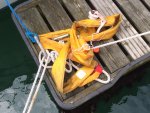Ohlin Karcher
N/A
My Jon Buoy automatic inflation danbuoy got snagged, went in the sea, and self inflated. I pulled it out with a boathook. It just has a normal 33g CO2 bottle which I got the same day (from East Coast Marine in Scarborough, a good little chandlers).
The thing doesn't want to fold up and go back into its box, so I can use it again going down the coast. No instructions on the web how to fold it.
I phoned Ocean Safety the makers, and they said, "We do not give out repacking instructions for them, that's not how we operate. You have to take it to one of our centres, and give it to us, and there will be a charge of 20 something pounds plus VAT"
So I have a choice, either guess how to pack it properly, and not be sure if it will work next time.
Or stow it somewhere in my boat, which is full if people and stuff already, and carry an expensive but useless piece of equipment to So'ton and pay them to fold it. (Oh, and buy another danbuoy at the chandlers for the trip down. )
There is something wrong with this situation, why don't they just publish folding instructions, it would be so easy. The technology is less than a normal lifejacket ( no salt button or hamar diaphragm.)
These items are useless for cruising if you can't repack them.
Maybe I should use the bits and just seize the weight, flag, drogue and light on a broom stick, it would seem to be the sensible course.
The thing doesn't want to fold up and go back into its box, so I can use it again going down the coast. No instructions on the web how to fold it.
I phoned Ocean Safety the makers, and they said, "We do not give out repacking instructions for them, that's not how we operate. You have to take it to one of our centres, and give it to us, and there will be a charge of 20 something pounds plus VAT"
So I have a choice, either guess how to pack it properly, and not be sure if it will work next time.
Or stow it somewhere in my boat, which is full if people and stuff already, and carry an expensive but useless piece of equipment to So'ton and pay them to fold it. (Oh, and buy another danbuoy at the chandlers for the trip down. )
There is something wrong with this situation, why don't they just publish folding instructions, it would be so easy. The technology is less than a normal lifejacket ( no salt button or hamar diaphragm.)
These items are useless for cruising if you can't repack them.
Maybe I should use the bits and just seize the weight, flag, drogue and light on a broom stick, it would seem to be the sensible course.

